As most of you will be aware, it’s not a Corolla or a Commodore that’s the best selling new vehicle in the Kiwi marketplace, but a ute of some description. For a couple of years now the Ford Ranger has been the best selling new ‘car’, duking it out with the old Hilux and now the new eighth-gen model and they’re closely followed by the likes of Navara, Triton and Colorado.
And we thought SUVs were popular! There’s no single reason why ute sales have gone ape crazy, though on first principles you’d expect it’s because they’re every bit as practical as an SUV but can be purchased for much less, once the usual discounts are applied. Moreover, they’re better specified than ever, and nowadays they perform and ride much better than ever before. On top of all that, they’re seriously off-road ready in 4WD guise, with 4H and 4L settings, and most can tow at least three-tonne braked loads, and some (like this pair) as much as 3.5 tonnes. The look of most of the modern pick-ups is also appealing, the Ranger reminding strongly of the F150; they just look tough, the sort of thing an All Black might drive.
It’s their practicality, ruggedness and bang for buck that appeal strongly then. When we had the Navara we twice loaded it up with fire wood. The trays can tote about a tonne and the load of manuka can’t have been far off that much. Yet the Navara hardly noticed it was there, except maybe over the odd bump. It would have been similar for the Toyota, I’m sure, but I took the Navara anyway. For reasons we’ll reveal later, unrelated to transmission differences.
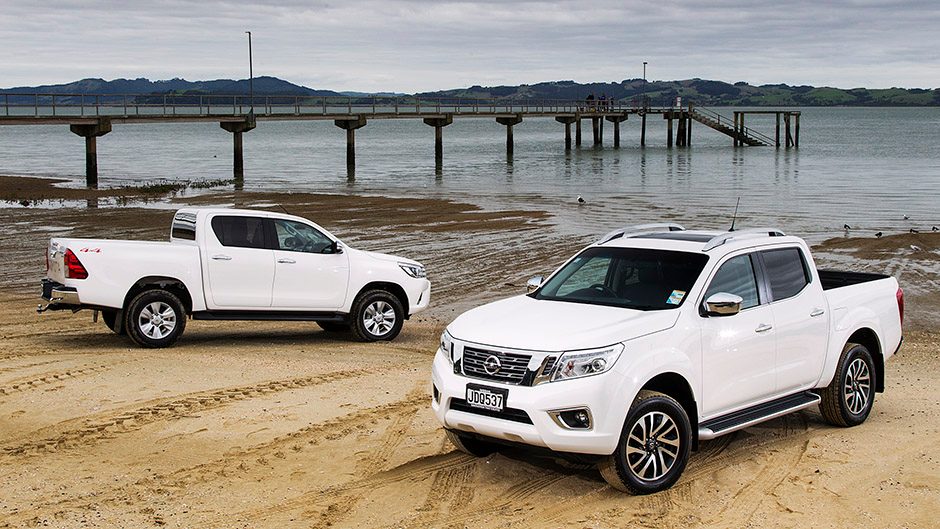
In recent months we’ve compared a few of the new trucks in the sector, the NP300 Narava accounting for the Triton and VW Amarok, while the facelifted Ranger roughed up the new Hilux in auto guise. How then does the winner of the three-way compare with the new Toyota in manual trim? That’s what we were wondering when an SR5 arrived on our doorstep for testing, with six-speed shift-it-yerself transmission. We couldn’t source a manual variant of the range topping ST-X Navara for a proper head-to-head but an auto was available so we jumped at that.
List price for the pair doesn’t mean that’s what you’ll pay, but it’s a place to start the negotiations. In the case of the newest, the Hilux SR5, the manual version powered by the new 2.8 turbodiesel retails for $63,990. An auto Limited supposedly sets you back over $70k whereas the top Navara powered by the new 2.3 biturbodiesel costs $64,990. Score one for the Nissan then, not just because it’s less expensive (if both were in auto guise) but also because it’s better specified (leather trim, for example) and gains an extra gear. Items present in this but not the SR5 include a panoramic sunroof, dual zone vs single zone climate air con, heated seats, roof rails, and heated door mirrors. There’s also an electric sliding rear window section so the dog on the back can better hear what the driver’s screaming at him. And a sliding tie down system in the tray compared with four hooks for the Toyota.
Navara rides on 18-inch rims, the Toyota on 17s. Both vehicles come with five-star ANCAP ratings and seven airbags each, smart keys and comfort entry, touch screens, cruise control, power driver’s seat (lumbar pump on the Nissan only) LED headlights and daytime running lights, hill start assist, sat nav, Bluetooth, and a rear view camera with parking sensors. What does the Toyota get alone? A four-way adjustable steering column; that in the Nissan is height-adjustable only.
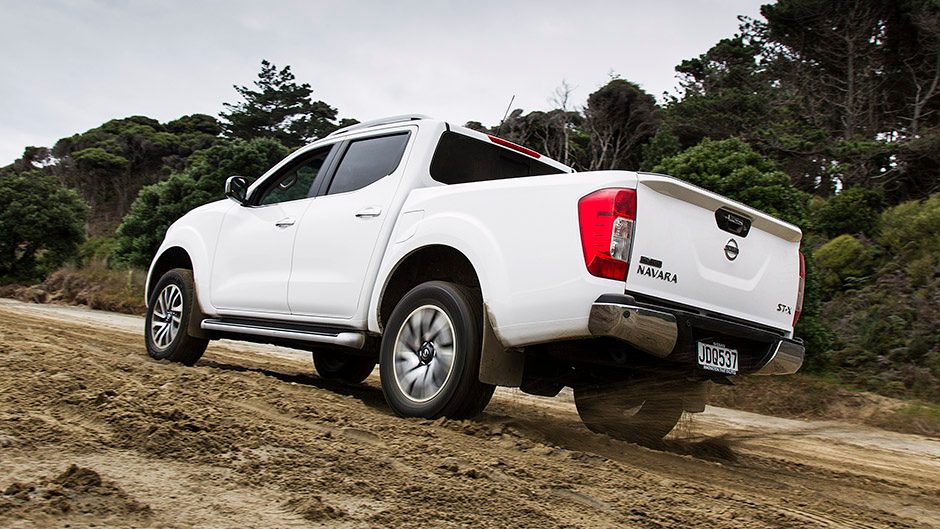
These vehicles are bloody enormous. Shockingly so if you haven’t driven a ute lately. The Mrs demurred, reckoned she’d never find a park big enough. Wrong again, they do fit, just (each is 1850mm wide). Both are well over 5m in length, have turning circles in the 12m range and they require a heap of twirling, with 3.5 turns lock to lock. Interior space is similar; there’s room for three adults in the back, with superior head clearance in the Hilux as it has no powered sunroof, and a touch more leg room. The Nissan’s wellside is bigger in the new D23, but the latest Hilux still has a slightly larger load tray, bigger for width and length, similar for height. Rear seats on both lift up if you’ve bulky stuff to cart and you want it locked away, out of the weather. There are also storage spaces beneath the rear seats of each vehicle for tools and whatnot.
The Karen Walker styling award goes to the Navara, no question. One simply looks macho and the other displays what Toyota describes as a “keen look” with slimline projectors part of the integrated fascia. We reckon it’s a bit snout led. There’s something almost American in the styling of the Navara, and we like the view from the wheel too because the bonnet creases remind, I kid you not, of a 911. Its V-motion grille works too. At the rear, there’s a wee spoiler integrated into the tailgate that appears too perfectly shaped for balancing beer bottles to have happened by accident. The devil, as they say, is in the details.
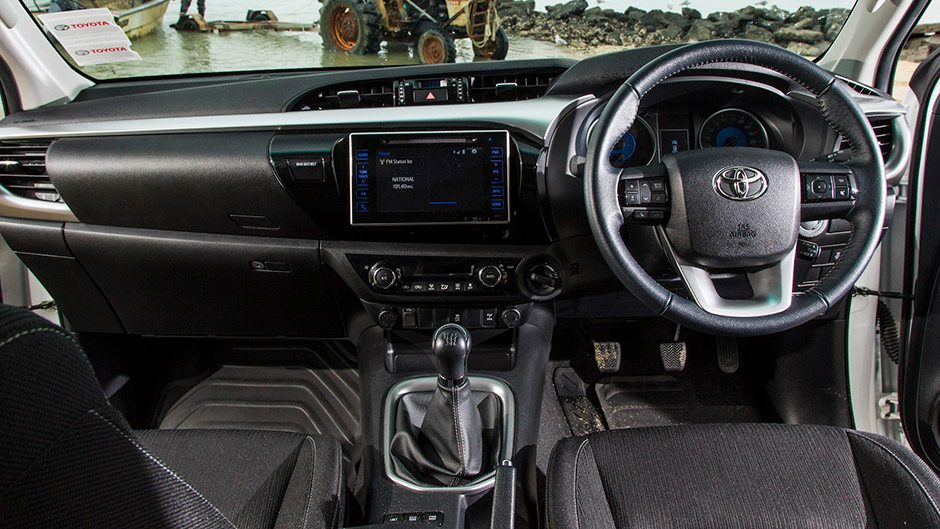
So down to the nitty gritty of this pair, both of which we have featured already in past issues (Aug 15 and Mar 16). Let’s not therefore go into too much depth. And we didn’t really go too far offroad with them either, just a foray onto a sandy beach where the Navara proved slightly better on the doughnut test (easier at the wheel). New eighth-generation Hilux has added ground clearance, enhanced articulation and underbody protection and, in 4WD versions, rear diff lock for improved off-road performance. Its new 1GD 2.8 engine offers a 25 per cent lift in torque (for the auto, at any rate) and 10 per cent better fuel economy.
There’s not a whole lot of difference in terms of output between the pair, the smaller 2.3 Navara benefitting from a pair of turbos, conjuring up 140kW, and 450Nm from 1500rpm. Hilux gets the new Prado engine, with the same torque tally as the Nissan, at least in auto guise (420Nm for the manual) but 10kW less. However, its 130kW chimes in earlier at 3000rpm, and 80 per cent of peak torque is delivered at 1200rpm. The Toyota weighs 80kg more but we thought it felt as sprightly as the Nissan, especially with its power mode button in play. But it’s for sure noisier in the cabin, the engine clamour more noticeable inside than the Navara’s. And it doesn’t rev as cleanly either, nor is rev range as extended, which is probably why the Nissan was almost a second quicker on both performance criteria we use. Not that you’d especially pick that from the driver’s seat. The Hilux is quite a goer in its latest guise. We got better figures from the manual than the automatic version which is roughly half a second slower again. That’s odd given the manual has less torque. Go figure.
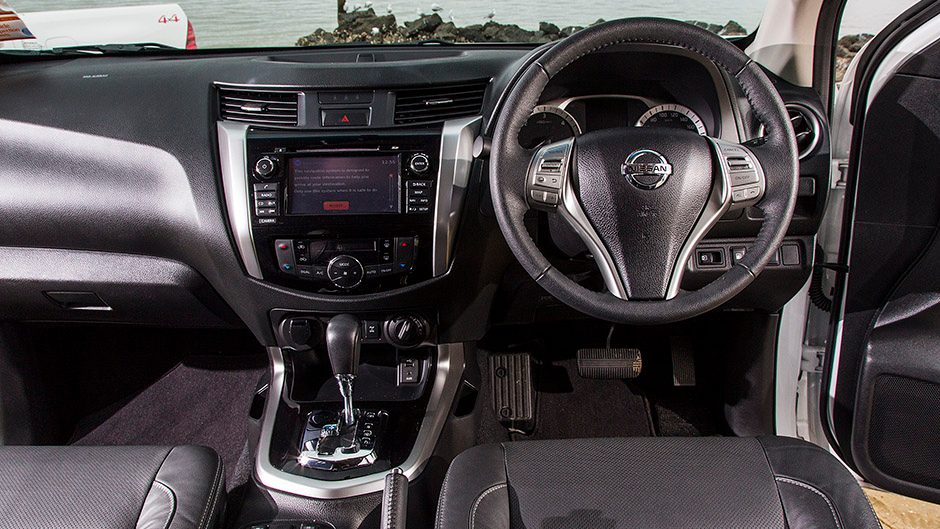
Where these two are rather different on road is in their ride and handling attributes. Toyota says it has worked hard to make this the most refined Hilux yet, but Nissan has done the same, with a bit of left-field thinking, and has opted to employ a five-link coil spring set-up at the rear. It works, though the unladen ride is still a wee bit jiggly – what ute isn’t? – and perhaps not quite as easy-going as that of the Amarok but it’s a far cry from the fidgety ride offered by Hilux. Even on parts of the motorway it can seem unhappy and on typical B-highways the suspension seems to pick up every indentation going, and the ride can become tiring all too quickly. The energetic performance of the engine only partway compensates.
Come cornering time and the Nissan again jumps ahead, probably for two reasons. One, the new 2.3 engine is 60kg lighter than the former 2.5 in the Navara so there’s not so much mass over the front axle, and secondly the Navara tyres look set-up more for road work whereas those on the Hilux appear readier for down and dirty action. Whatever, the Nissan displays less front end push, less squealing in corners and is easier (and more comfy) as a result to thread down a winding road. What seals it is the feel at the helm with some measure of road sensitivity in the Nissan and the Hilux playing numb.
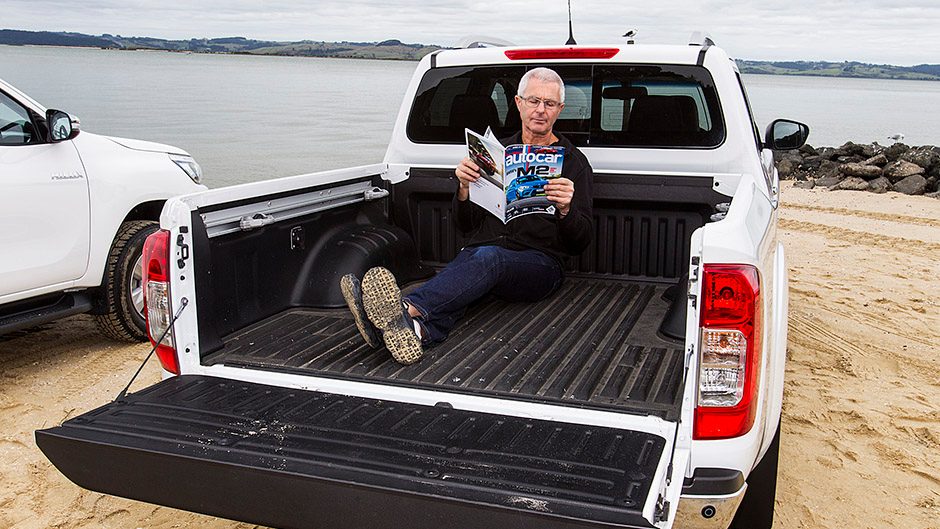
As for the cabins, there’s not so much in it. I’m not a fan of digital volume controls so don’t much like the Hilux infortainment unit. And the Navara instruments look classier. Seats are a bit better in the Nissan too, though in the back your knees are a touch more elevated than in the Toyota.
This might seem like a fairly comprehensive win to the Nissan which looks, drives, and rides better, and has more specification at a lesser cost. Moreover, its 20,000km 12-month service intervals compare with 15,000km schedules for Hilux. Things are closer than they may seem on the performance front but there’s no area where the Hilux trounces the Navara. Perhaps that’s why the Nissan recently won the European 2016 International Pick-up of the Year award. Not that any of this will have the remotest impact on sales figures because folk still buy the badge and all that stands for rather than the product.
| Model | Nissan Navara ST-X Double Cab 4wd | Price | $64,990 |
| Engine | 2298cc, IL4, T/DI, 140kW/450Nm | Drivetrain | 7-speed auto, switchable 4×4 |
| Fuel Use | 7.0L/100km | C02 Output | 186g/km |
| 0-100km/h | 9.91secsec | Weight | 1999kg |
| Model | Toyota Hilux SR5 4×4 | Price | $66,490 |
| Engine | 2755cc, IL4, TDI, 130kW/450Nm | Drivetrain | 6-speed auto, switchable 4×4 |
| Fuel Use | 8.5L/100km | C02 Output | 223g/km |
| 0-100km/h | 11.54sec | Weight | 2120kg |


